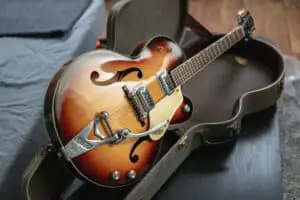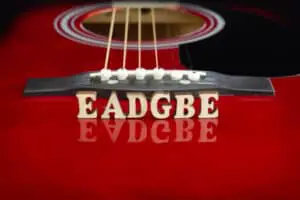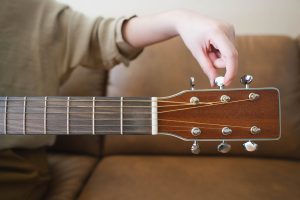
Before you start learning the guitar, it’s advisable to learn its parts. An introduction to the different parts of the instrument you’ll spend hours playing is vital in your learning process.
Asides from it being a good knowledge to have, knowing the different guitar parts can help you understand the part they play in creating the guitar’s distinct sound. The guitar’s headstock is one of those parts that has a significant role in creating the guitar’s sound.
So what is the headstock of a guitar?
The headstock of a guitar is the part of the guitar located at the upper portion of the guitar’s neck. They are where the guitar’s strings end or start, whichever way you look at it. They also house the tuning pegs, trust rods, and nuts.
Here, we’ll dive into the guitar’s headstock and its role in producing guitar sounds. We’ll also look at the major types of headstocks, their merits, and their demerits.
What is the Headstock of a Guitar?
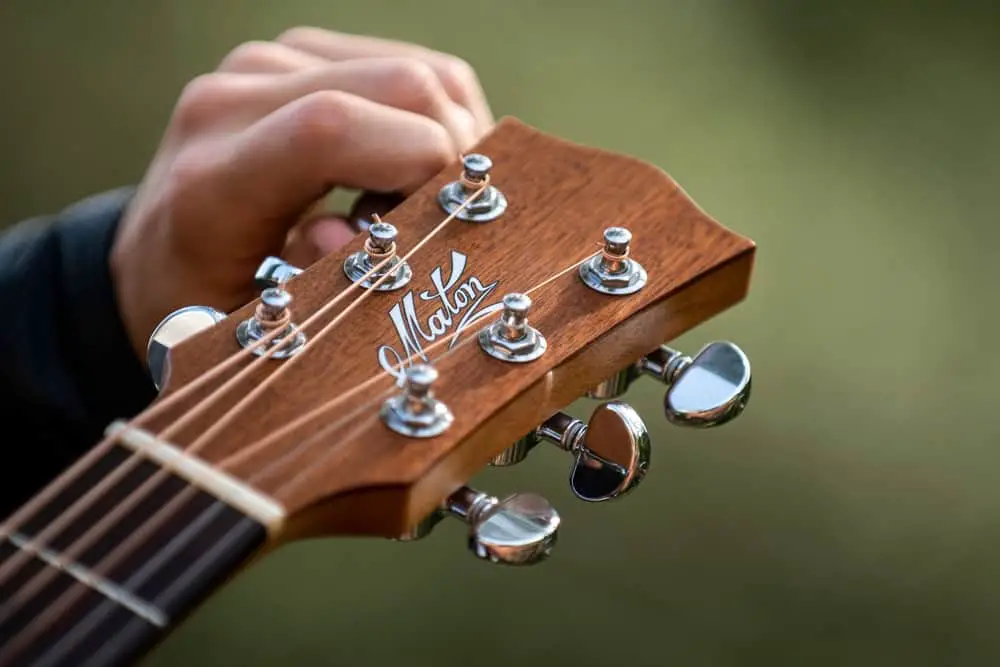
A guitar’s headstock is located at its top and is connected to its neck. Being a home of the guitar’s tuning pegs, the guitar headstock’s primary function is to tune the strings and hold them in place after tuning. Here are some of the guitar parts you’ll find on the headstock.
Nuts
These are located at the end of the neck, just before the headstock. They are usually made of ivory, ebony, synthetic materials, or brass. Their primary function is to maintain an accurate distance between the string and the fingerboard. They also set and hold the spacing between two strings.
Tuning Pegs
The tuning pegs are arguably the most important of the guitar. The guitar’s sound will be irregular and unpleasant to the ear without them. Tuning pegs are used to adjust the tension on the strings, affecting their pitch and the sound they produce.
Truss Rod
Tuning pegs or machine head controls the tension on the guitar’s strings, and the truss rods control that of the guitar’s neck. Most guitars provide access to the truss rod from the headstock, slightly above the nuts. The truss rods come in various lengths and are placed underneath the guitar’s fingerboard.
Headstock Head
The headstock head can be found at the top of the headstock. It’s usually where the guitar manufacturer/brand’s name is placed.
Types of Headstock
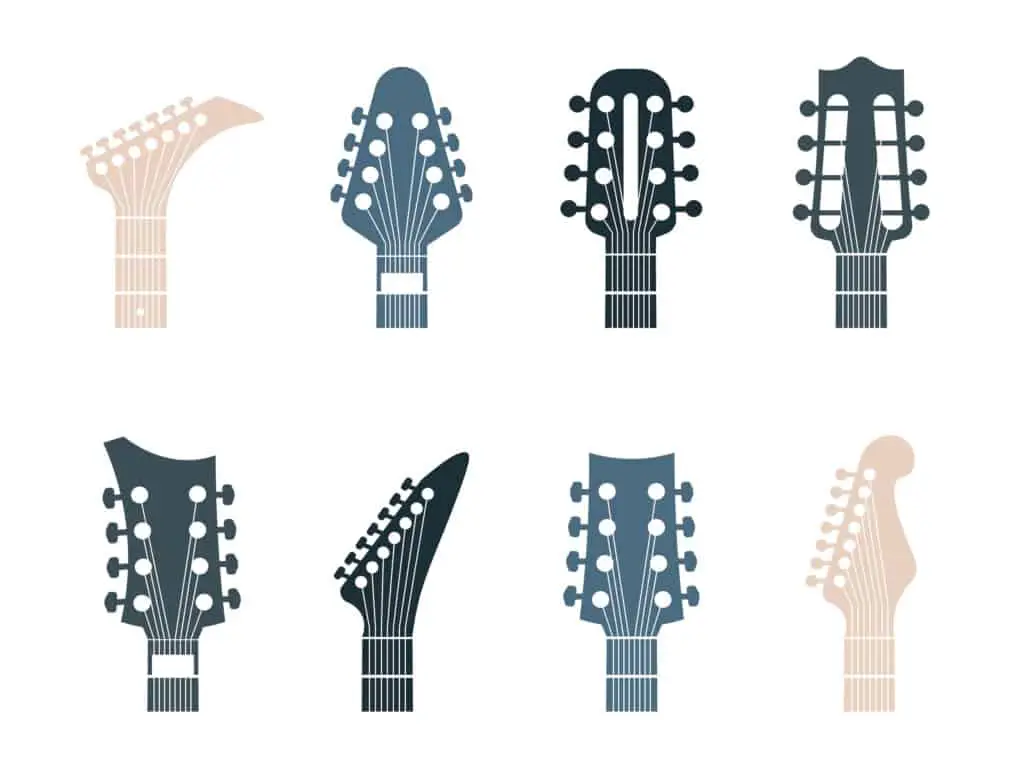
The headstock comes in different types and designs. Many guitar manufacturers use their headstock designs to distinguish themselves from others. But in the end, there are three major types of guitar headstocks, and the rest are mere modifications of these three. Here are the three.
Straight Headstock
Straight headstocks are the most common type of headstocks. As their name implies, they are straight with no curves.
They are also very cheap because they are produced with a single piece of flat wood used for both the neck and the headstock. This also makes them easy to produce, and that’s why they are usually manufactured in large quantities.
Also, guitars with straight headstocks have proven to possess a higher strength than others.
Advantages of the Straight Headstock
Since they only use one piece of wood for both the neck and headstock, there’s a significant drop in manufacturing costs. That’s why they are mostly cheaper than other headstock types.
Disadvantages of the Straight Headstock
Many guitarists believe that the straight headstock design does not allow the guitar’s nut to hold down the strings properly. Resulting in the guitar’s inability to maintain a particular tune.
Tilted-Back Headstock
Like the straight guitar headstock, the tilted-back headstock uses a single piece of flat wood for the neck and headstock.
The major difference between the two is the angular curve the headstock makes with the neck; they’re more complicated to produce. Titled-back headstocks are common in mid to high-level guitars like Gibson or Ibanez.
Advantages of Tilted-Back Headstocks
The tilted-back headstock corrects the flaw of the straight headstock in that they have mechanisms that allow the guitar’s nuts to hold down the strings stronger. With this, the guitar can maintain a particular tune as the instrument’s strings are less likely to slip out.
Also, there’s a common belief among guitarists that titled-back headstocks produce expressive and lively sounds. Although this has not been proven, many believe they play better with a tilted-back headstock.
Disadvantages of Tilted-Back Headstocks
While they use a single piece of flat wood for their production, titled-back headstocks will require more material due to the angular headstock curve.
The curve also gives it a longer manufacturing time, and if you combine this with the cost of production materials, you’ll see why they cost more than straight headstocks.
Secondly, guitars with tilted-back headstocks are not durable. The angular curve’s tension between the neck and headstock makes it more susceptible to breaking.
Gibson guitars are the biggest producers of guitars with tilted-back headstocks, and their guitars have proven to be very fragile. Their headstocks are notorious for snapping off when they come against a hard surface; this is mainly due to the steep curve in their guitars.
Scarf Headstocks
Scarf headstocks are similar to tilted-back headstocks in that they both have curves between the neck and the headstock. The major difference between the two is that the scarf headstocks do not use a single piece of wood throughout. The wood for the headstock and that of the neck are both separate, and they are both joined at an angle and glued together.
Advantages of Scarf Headstocks
They allow the guitar’s nuts to tightly hold the strings like titled-back headstocks. Allowing the guitar to hold tuning.
Also, the neck and headstock being glued together makes them stronger and less susceptible to breaking. Scarf Headstocks offer the strength of a straight headstock and the technicality of a titled-back headstock.
Disadvantages of Scarf Headstocks
Scarfed headstocks are not easy to produce. The complexity of joining two pieces of wood at a perfect angle requires experience and time, lots of time.
They are still cheaper than tilted-back headstocks because they require less material, but they are more expensive than straight headstocks.
The Bottom Line
A Guitar headstock is the part of the guitar above the neck and holds the tuning pegs, nuts, and sometimes, truss rods.
They are the only parts of the guitar that can be trademarked, and that’s why we see so many headstocks designs today. However, these designs are nothing but brilliant modifications of the three major types; the straight, tilted-back, and scarf headstocks.

